Menus
- The Alpine mega test 2010: super athletes, enduros and the final
- Enduro / fun bike comparison
- Enduro / fun bike measured values
- Conclusion
- Super athlete comparison
- Super athlete readings
- Conclusion
- The final round
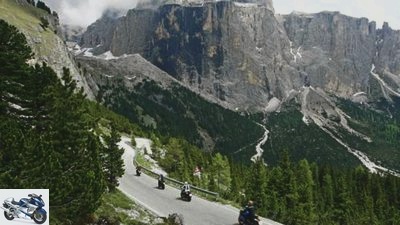
Gargolov
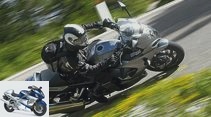
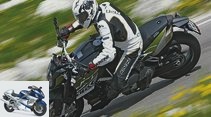
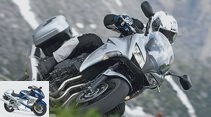
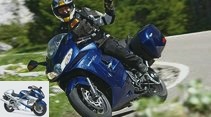
45 photos
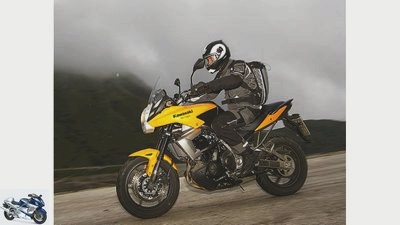
1/45
A flexible, high-torque engine is hidden in the Kawasaki Versys, but the Kawa cannot keep up with the BMW or the Ducati. The also low payload and sparse equipment therefore banish the Versys to fourth place in the enduro field.
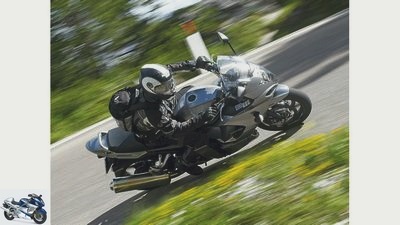
Gargolov
2/45
The Suzuki GSX 1250 FA clearly has the best engine in the field. Although the comfort leaves a little to be desired, the Suzuki makes no further blunders and therefore just makes it onto the podium.
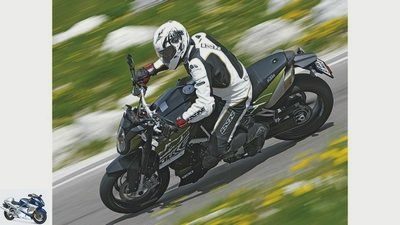
Gargolov
3/45
The KTM 990 Superduke is handy and the suspension is super tuned. But for a longer trip, there is a significant lack of comfort and suitability for everyday use. It is therefore not enough for the KTM to finish more than fourth.
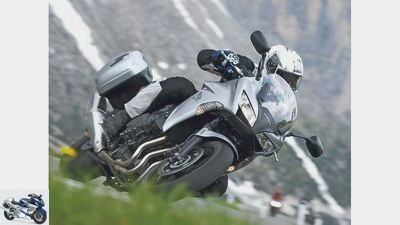
Gargolov
4/45
The Honda CBF 1000 F has it all: a cultivated, economical engine, super comfort for long journeys, and a fantastic chassis. Although the Honda has to back off a bit, as the engine is not quite as powerful as the competition, it is clearly enough for first place.
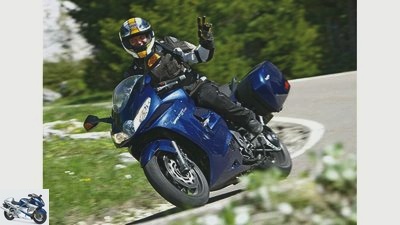
Gargolov
5/45
With a great engine and a usable chassis, the Triumph Sprint GT can be at the forefront. Although it does even better than the Suzuki in the everyday rating, it cannot prevail in the comparison and only claims second place.
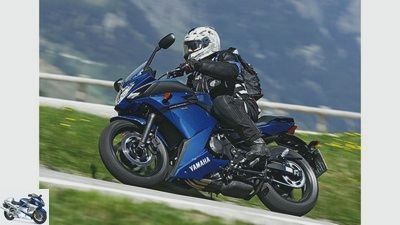
Gargolov
6/45
Excellent handling and a comfortable and well-tuned chassis bring the Yamaha XJ6 Diversion F some points. But since it was not designed for long-distance travel, it cannot get past the Honda at the Alpine Masters and lands in second place.
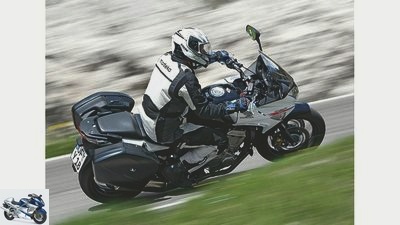
Gargolov
7/45
Honda can also convince with the all-rounders. A sharp chassis, a sophisticated engine and the most comfortable all-rounder make the Honda CBF 600. Smaller compromises in the passage can no longer prevent the Honda from first place.
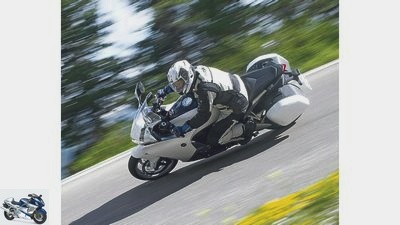
Gargolov
8/45
With a partially integral brake and dual clutch transmission, the Honda VFR 1200 F can technically be at the forefront. In practice, however, the VFR is unfortunately not convincing because either too little or too much power develops. Since the equipment also has some deficiencies, the Honda is only enough for third place.
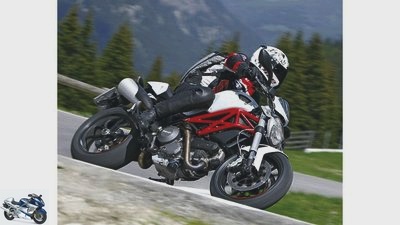
Gargolov
9/45
A lively, powerful engine that consumes little speaks for the Ducati Monster 796, unfortunately the pulling power from low speeds is extremely poor. Comfort and chassis are also not really convincing and drop the Ducati into fourth place.
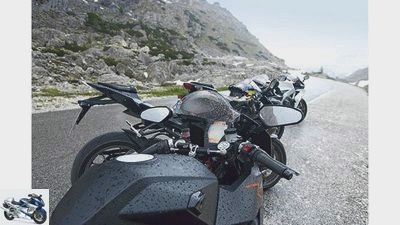
Gargolov
10/45
But unfortunately the weather didn’t always play along.
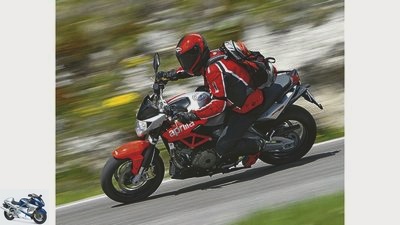
Gargolov
11/45
An elastic and powerful engine, with low consumption, paired with high comfort: the Aprilia SL 750 Shiver. Since there are no other advantages for the Aprilia, the Shiver falls back to 3rd place.

Gargolov
12/45
Very good handling and a comfortably tuned chassis speak for the Suzuki GSX-R 750, but due to the displacement disadvantage, the Suzuki shows itself to be weak. The lack of ABS is another flaw. The Suzuki therefore does not manage to overtake the BMW and ends in second place.
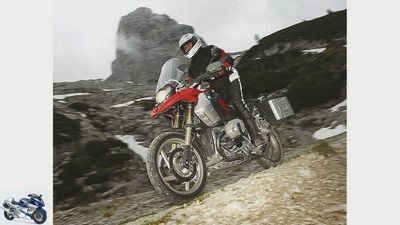
Gargolov
13/45
The BMW R 1200 GS also shines with an excellent engine and a great chassis. The smart accessories and the wide range of uses of the GS provide comfort, even with the somewhat low payload, and push the GS onto the enduro podium.
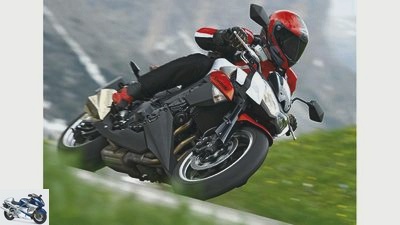
Gargolov
14/45
The engine of the Kawasaki Z 1000 is a stunner and still impresses with its low consumption. But since the chassis and handling are so stubborn, the Kawasaki clearly loses ground in the practical test and lands in third place.
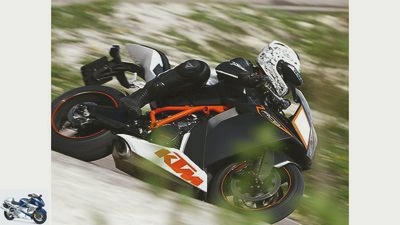
Gargolov
15/45
The KTM 1190 RC8 R impresses with its amazingly comfortable seating position and extensive, high-quality equipment. Unfortunately the KTM is losing ground due to the lack of ABS and an unbalanced chassis. It therefore only ends up in third place.
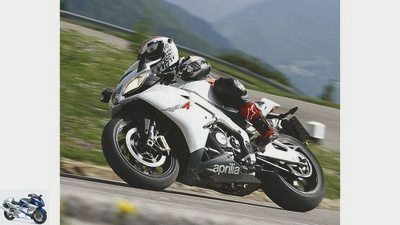
Gargolov
16/45
The Aprilia RSV4 R is a bike that was actually designed for the racetrack, and therefore shows amazing chassis and braking properties. But the Aprilia is simply not made for traveling in the Alps – far too uncomfortable and an engine that is too uncultivated, the Aprilia only comes in fourth.
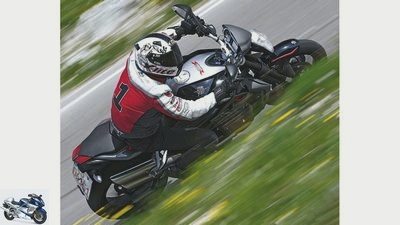
Gargolov
17/45
The MV Agusta Brutale 1090 RR impresses with an engine that is just as ingenious as the Kawasaki Z 1000, but the enormously high consumption leads to a number of point losses. Since the chassis is well tuned and the Brutale is great to drive, it’s enough for second place.
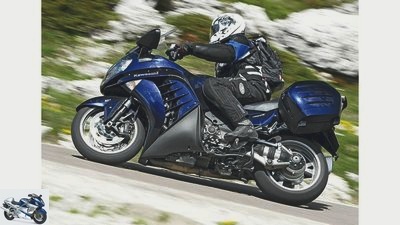
Gargolov
18/45
The Kawasaki 1400 GTR scores especially with its equipment and seating comfort. On the other hand, the performance on the road can hardly convince, the cornering stability and steering precision unfortunately leave a lot to be desired. Since the engine is also one of the weakest in the overall field, the Kawasaki only remains fourth.
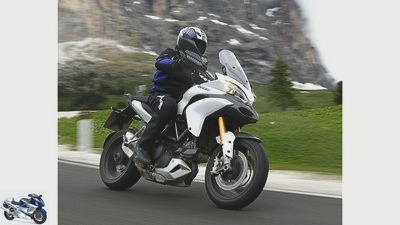
19/45
Typical for Ducati: The sensual fiery engine and ingenious handling. Another plus point are the various driving modes that electronically adjust the chassis and engine. However, due to some weaknesses in the chassis setup and the transmission, the Ducati Multistrada 1200 S only made it to second place.
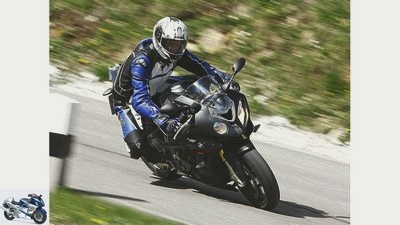
Gargolov
20/45
The BMW is not very suitable for traveling in the Alps, as luggage storage is not desired and the seating position is not good for longer journeys. But with the most powerful engine, a lot of technical and electronic helpers, the BMW S 1000 RR manages to drive the competition into the ground and can thus achieve first place.
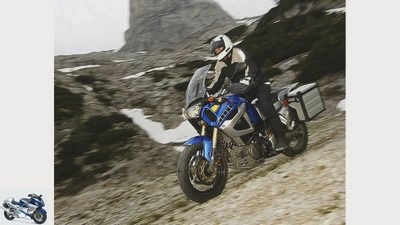
Gargolov
21/45
The new Yamaha XT 1200 Z Super Tenere is a jewel for travel. This is underlined by a high payload and a wide range of equipment as well as superior seating comfort. However, the high consumption and the still quite modest power delivery let the Super Tenere fall back to third place.
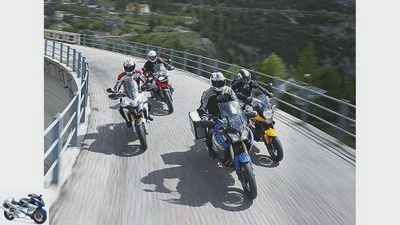
22/45
Like tourers, enduros are suitable as travel motorcycles. Behind high handlebars, you can relax and climb the mountains with confidence. In the field: the BMW R 1200 GS, the Ducati Multistrada 1200 S, the Kawasaki Versys and the Yamaha XTZ 1200 T Super Tenere.
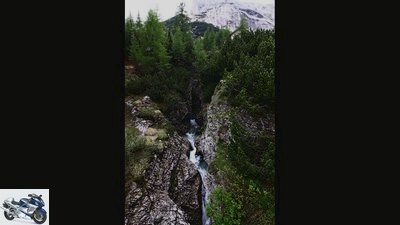
Fig
23/45
The path leads past beautiful rock and landscape formations. But the view should not be too far from the streets, as the pavement often shows signs of frost.
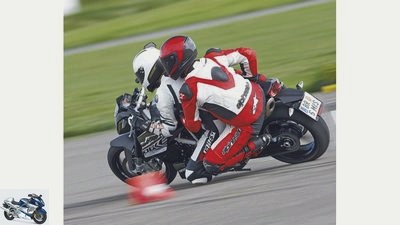
Gargolov
24/45
Interesting: In the pillion test, the big bikes were able to ride at the very front in the slalom.
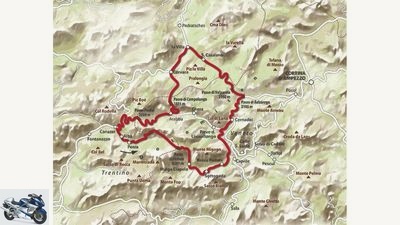
Drawing: Werel
25/45
Finally, a look at the test route of this year’s Alpenmasters in the Dolomites.

26/45
In bad weather and wet roads, the CBF of all people lay down and had to go to the workshop.
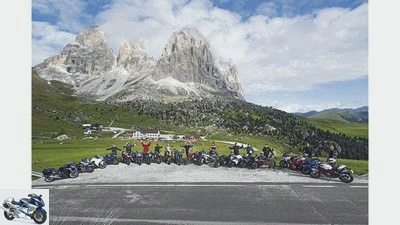
27/45
This year again, a group of MOTORRAD testers with 20 bikes set out for the Alps to find the mountain goat among them. This year, the testers will travel to the Dolomites over the Sella Joch to Canazei to start the tests from there.
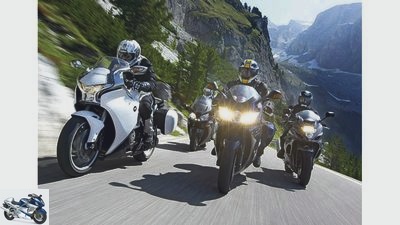
Gargolov
28/45
The tourers appear to be made for the Alpine landscape. You can enjoy the panorama without any problems and glide smoothly through curves. This time the latest tourers Honda VFR 1200 F DCT, Kawasaki 1400 GTR, Suzuki GSX 1250 FA and Triumph Sprint GT are in the field.

Gargolov
29/45
Again and again it goes up the mountain, over the passes Passo di Fedaia, Passo di Falzarego, Passo di Valparola, Passo di Campolongo and finally over the Passo Pordoi.
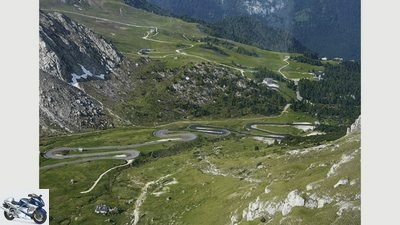
30/45
From there it went over serpentine stretches via Sottoguda to Cernadoi and via la Villa back to Canazei.
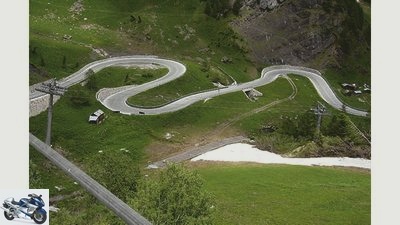
Mayer
31/45
Ready to go again, we’re back on the roads of the Dolomites.
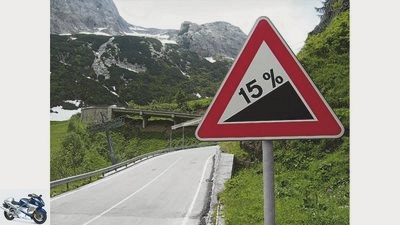
Gargolov
32/45
Watch out! Here it goes down properly.
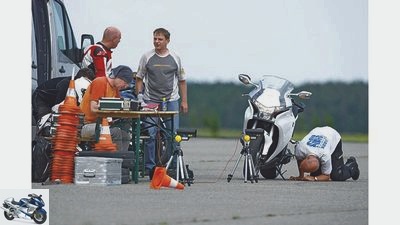
Gargolov
33/45
In addition to the trips in the Alps, a detour to the test track is also necessary.
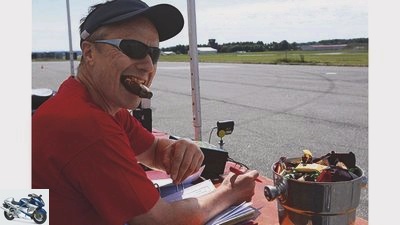
Jahn
34/45
Very important for a tester: a balanced diet to stay relaxed in the heat and stress.
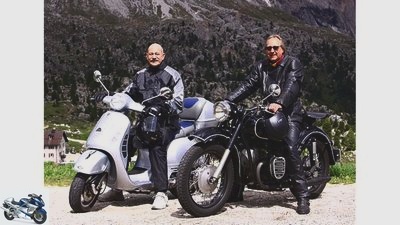
Fig
35/45
This time the Hupe brothers from Recklingshausen with Russian boxers and Vespa.
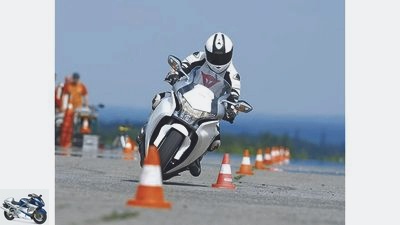
Gargolov
36/45
Only here can limit areas in slalom and handling be reached. Such tests would be insane on public roads.
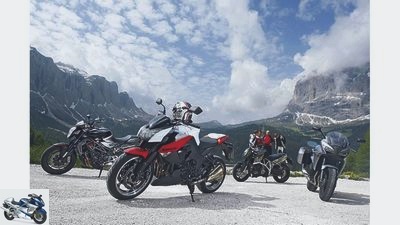
Gargolov
37/45
The most modern chassis and torque in abundance characterize the Bik bikes. Will that help them win the Alpenmasters? This year: the Honda CBF 1000 F, the Kawasaki Z 1000, the KTM 990 Superduke and the MV Agusta Brutale 1090 RR.
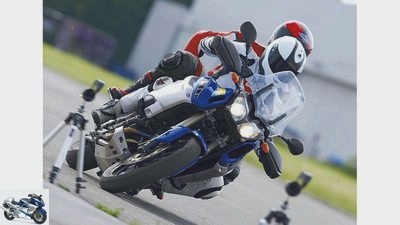
Gargolov
38/45
In addition, better equipment is available, like here with the pillion test.
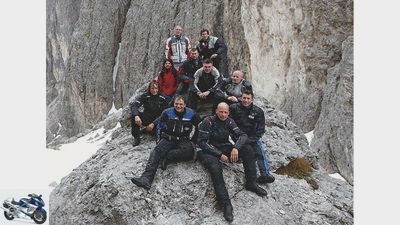
39/45
Like every year, an experienced test crew made up of seven MOTORRAD testers and three guests from Spain, Croatia and Sweden.
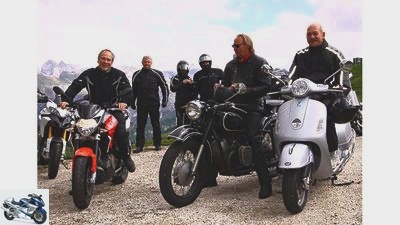
Fig
40/45
And like every year you meet interesting cyclists on the way who manage their tour on slightly different machines.
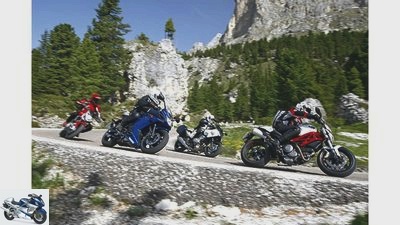
Gargolov
41/45
On tight bend roads, it’s not power that counts, but agility. A characteristic that is primarily attributed to smaller all-rounders. Whether the Aprilia SL 750 Shiver, the Ducati Monster 796, the Honda CBF 600 or the Yamaha XJ6 Diversion F confirm this?
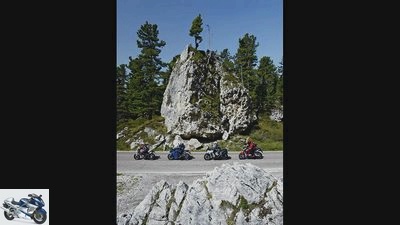
Gargolov
42/45
In addition, the varied mountains sweeten the tour.
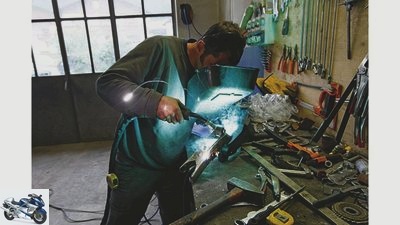
43/45
The left frame member had to be dismantled and the derailleur hanger welded on again.
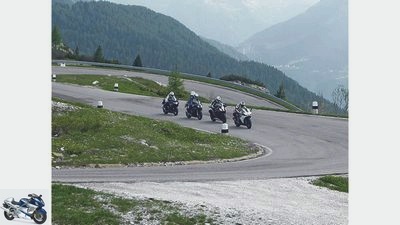
Gargolov
44/45
Here between Falzarego and Valparola.
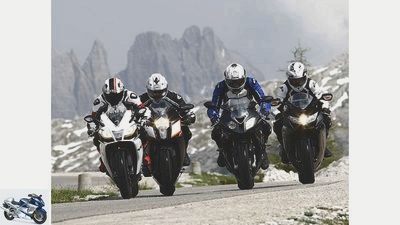
Gargolov
45/45
Actually built for completely different terrain, but an experience when driving in the Alps: super athletes. This time the Aprilia RSV4 R, the BMW S 1000 RR, the KTM 1190 RC8 R and the Suzuki GSX-R 750 are included.
Alpine Masters 2010: Part 2
The Alpine mega test 2010: super athletes, enduros and the final
Three finalists have already been determined, two more are now being determined. Together with the winner of last year’s Alpine Masters, the Honda CB 1300, the question of who the crown of the 2010 Alpine Masters belongs to will be answered in the bends and bends of the Dolomites.
Tens of thousands of motorcyclists can’t be wrong. Once a year, at least, they are drawn to the alpine lift, the mountain calls. People from half of Europe meet here, looking for the peak of fascination. You know, why. In one of the most beautiful touring areas there are spectacular alpine passes for every taste, lots of curves and high roads. When hairpin turns and hairpin bends and slopes (or slopes) of up to 20 percent have to be overcome for kilometers, it is great to ride a motorcycle.
Und perfect test. In the world of rock and ice, lush meadows and dark forests, the strengths and weaknesses of the respective machine concepts reveal themselves in fast motion on drastic height differences. For this reason, MOTORRAD has traditionally organized the largest test of every year since 2005 in alpine regions. A microcosm that relentlessly reveals the big picture. Motorcycles that do not demand, but encourage fluid driving style, have a clear advantage here. Machines that keep their driver calm when things get tough.
Buy complete article
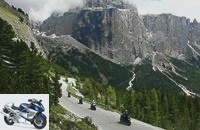
Alpine Masters 2010: Part 2
The Alpine mega test 2010: super athletes, enduros and the final

Naked bike
Alpine Masters 2010: Part 1
Alpine mega test 2010: Tourers, big bikes and all-rounders
read more
Enduro / fun bike comparison
Like tourers, enduros are suitable as travel motorcycles. Behind high handlebars, you can relax and climb the mountains with confidence. In the field: the BMW R 1200 GS, the Ducati Multistrada 1200 S, the Kawasaki Versys and the Yamaha XTZ 1200 T Super Tenere.
Travel broad-shouldered, sit relaxed behind high handlebars and climb the mountains with ease and confidence – this is what travel enduros invite you to do. The BMW R 1200 GS, the Ducati Multistrada 1200 S, the Kawasaki Versys and the
Yamaha XTZ 1200 Z Super Tenere.
Can this be? According to the calendar it is early summer, the sensation says late autumn, cool and gray. And spring rattles, gentians and bluebells in all colors bloom on the mountain meadows. This test field is similarly colorful, red, white, yellow and blue. This is where four unmistakable ABS-equipped two-cylinders meet. The BMW R 1200 GS traditionally competes with a boxer, since 2010 with two overhead cam winders in the two protruding cylinders.
Dohc heads? Nothing special for the Ducati Multistrada 1200 S. You don’t talk about that, you have it. A matter of honor, the real V2 fun bike has a superbike high-tech engine that has been “tamed” to 148 hp. The Kawasaki Versys marks the other end of the spectrum. A light, manoeuvrable all-rounder with a 64 hp in-line engine. The Yamaha XT 1200 Z Super Tenere also relies on this engine concept. Quasi the rolling frontal attack on the GS. With electronically controlled throttle, traction control and cardan. Also adjustable seat height, composite brake and tubeless spoked wheels.
Gargolov
The new Yamaha XT 1200 Z Super Tenere is a jewel for travel. This is underlined by a high payload and a wide range of equipment as well as superior seating comfort. However, the high consumption and the still quite modest power delivery let the Super Tenere fall back to third place.
Chic, the long-awaited Super Tenere. The "First edition" runs the whole feel-good program: main stand, hand protectors, headlight stone guard and less voluminous aluminum cases at no extra charge. The 1200 twin snorts unobtrusively out of the voluminous steel silencer when the button is pressed. The gears of the gearbox can be sorted easily, the cardan cannot be felt. A fine drive train.
What one can only say to a limited extent about the engine – not very easy to turn, sedate and phlegmatic. Uphill from the bends of the Pordoijoch, the super Tatara starves to death with kettledrums and trumpets. Too little bang from below. The XTZ, which weighs 267 kilograms, takes longer than the half-displacement Kawasaki Versys for gradients in second gear from 25 to 75. How can that be? Apparently, Yamaha takes the cliff of noise measurement at 50 km / h with aisle-specific throttling.
In the second and third gear, the already less voluminous torque curve remains flat between 80 and 85 Newton meters from 3000 to 4000 tours. In the second, it then falls at 5500 rpm into a crater-deep hole of a good 65 Newton meters. In the third, the power rises sharply above the 4000 mark, but never reaches the values for gears four to six: a maximum of 90 hp in the second, 96 in the third and 100 in the sixth. While the official test motorcycle from the importer still produced 107 hp in previous tests, this 1200 series from the Yamaha dealer lets a maximum of 100 horses instead of the promised 110 horses run. Almost ten percent less performance, so the XTZ scrapes along the edge of versatility. This leaves a bland aftertaste, you have to switch damn often for a 1200. And the fuel consumption is high.
The wonderfully good-natured chassis can inspire: neutral, extremely comfortable and easy to swallow. Good balance and the 19-inch model in the front even allow ambitious detours on gravel. And then there is this sublime seating comfort: thanks to the high, sweeping handlebars and relaxed knee angles, you can endure endlessly in the super comfortable driver’s seat. Experience the Alps from the panorama armchair!
A flexible, high-torque engine is hidden in the Kawasaki Versys, but the Kawa cannot keep up with the BMW or the Ducati. The also low payload and sparse equipment therefore relegate the Versys to 4th place in the enduro field.
The Kawasaki Versys cannot serve with such box seats. Your seat is narrower and lower, the handlebars, which are not quite as wide, are closer to your chest. The 650 feels more compact when switching directly. You sit more in the motorcycle, but a little passive, indecisive. The 211-kilogram dwarf scurries through even the most complex of turns. The short translated Versys drives surprisingly fast, really cheeky. Assuming the right gear is in there, a notch or two lower than the other three "Enduros". You have to twirl the clearly vibrating twin quite a bit. Five or six thousand revolutions should already be there.
It sounds a little tinny, the sound that tunnel walls and galleries throw back. Great: The very economical parallel twin enables a dream range of 459 kilometers. That’s enough for a few sella laps. The huge panorama of the 3181 meter high Langkofel group (Italian: Sassolungo) inspires respect. Can the bikes withstand such a challenge? The Kawa is more sparsely equipped than other machines, it is the only one that drives without traction control and on-board computer. But it only costs half. Well, it works, on country roads in alpine regions as well as in urban turmoil. Only the feedback could be better. The Versys chassis looks doughier, more diffuse, less confident than the other three. The front brake appears a little blunt and requires a lot of hand strength.
Typical for Ducati: The sensual, fiery engine as well as ingenious handling. Another plus point are the various driving modes that electronically adjust the chassis and engine. However, due to some weaknesses in the chassis setup and the transmission, the Ducati Multistrada 1200 S only made it to second place.
Despite the hefty purchase price of 18,000 euros, quite a few Ducati Multistrada 1200 S are already out and about in the wild. Many have been waiting for this: superbike genes crossed with enduro habitus. A hot mixture, suitable for touring as well as spirited. The long-translated V2 doesn’t like to mess around. The extremely short-stroke hot spur jerks and chops in the lower rev range and needs at least 3000 rpm. But hold on in the middle of the speed. Of all 20 machines in the 2010 Alpine Masters, the Duc is the fastest in second gear from 25 to 75 km / h. When accelerating fully, she likes to lift her front wheel.
The V2 accelerates hard, jumps from a full angle onto the short straights, sniffs them in seconds. More sport than enduro, more lawn than travel – despite four driving modes that can be electronically adjusted while driving. You vary the damper settings of the Ohlins suspension elements and control the power output: a full 147 hp go to the rear wheel in both Sport and Touring modes; under Urban and Enduro there are still 100 hp left. Traction control intervenes late in touring mode and allows a prancing rear wheel at the exit of a curve.
On fat 17-inch wheels (190 tires in the back!) The Duc throws itself gleefully into the curves, greedily and precisely, waving lightly and easily. Ultimately, however, the suspension setup remains inhomogeneous: the upside-down fork is soft, the shock absorber is taut. The Brembo monoblocs brake superbly. It is raining again. Narrow, slippery when wet, the Multistrada footpegs offer little support.
Gargolov
The BMW R 1200 GS also shines with an excellent engine and a great chassis. The smart accessories and the wide range of uses of the GS provide comfort, even with the somewhat low payload, and push the GS onto the enduro podium.
The size of the BMW R 1200 GS intimidates smaller pilots. But even less experienced riders hang out from Yamaha and Kawasaki at will until you can hear and see. Mind you, this is not about heating. It’s about the potential of the motorcycle. And the 2010 GS simply got an extra helping of it.
The Dohc heads make the boxer fuller, more punchy at the bottom. At any speed, except at 3000 rpm, the GS clearly outperforms the even larger Yamaha engine. This cow can be milked properly. Powerful from below, lively in the middle and spontaneously on the gas, that’s how you like turn after turn, shift up very early. The new exhaust with valve makes the boxer sound full and robust for the first time. Substantial. In push mode, he may snort a bit too aggressively.
In addition to the powerful engine, the electronically adjustable chassis (ESA) makes you relaxed and lively. It spoils with a practical setting range and easy operation. Criticisms? Trample on short, hard cross joints and asphalt cracks. The extra-wide handlebar is so wide that you can hug the whole world. Even in wet conditions, the GS conveys a lot of trust and security and gets you through everywhere. As with the XTZ, the Metzeler Tourance EXP adheres well. Traction control and ABS regulate sensitively. Sheer driving pleasure is what the all-terrain GS delivers on every terrain.
Enduro / fun bike measured values
| BMW | Ducati | Kawasaki | Yamaha | |
| Fast slalom | Time (sec) | 22nd | 21.9 | 22.8 | 22nd |
| Vmax at the measuring point (km / h) | 102.6 | 97.6 | 97.3 | 98.8 |
| Circular path, Ø 46 m | Time sec | 11 | 11.5 | 11 | 11.5 |
| Vmax at the measuring point (km / h) | 50.2 | 48.6 | 50.4 | 47.6 |
| consumption | Test consumption passes l / 100 km | 4.6 | 5.7 | 4.1 | 5.7 |
| Theoretical range of passes (km) | 436 | 352 | 459 | 397 |
| acceleration | 0–140 km / h (sec) | 6.1 | 5.2 | 8.3 | 6.9 |
| Draft | ||||
| Passage at 2000 m above sea level N. N. 50-100 km / h | 7.1 | 6.8 | 9.2 | 9.2 | Pulling in 2nd gear uphill with a pillion passenger 25–75 km / h | 4.6 | 4.4 | 6.3 | 6.9 |
| Brake measurement downhill | ||||
| Braking distance 75-25 km / h with pillion passenger (m) | 23.1 | 24.7 | 27.1 | 26.8 |
Conclusion
The Kawasaki Versys is an economical all-rounder. It costs only half as much as the other three, but remains more than half as good. The new Yamaha Super Tenere combines top touring and everyday qualities. But her 1200 twin is pretty slow. The Ducati Multistrada embodies the exact opposite without enduro attributes: pure power. And yet it sits comfortably. The beefy BMW R 1200 GS bears the seal of approval "good-natured and confident". She shines with great versatility and deserves to make it to the finals.
Details:
BMW R 1200 GS
positive
- Engine beefy torque curve from bottom to top
- Chassis stable, easy to swallow
- Smart, cleverly designed accessories
- Range of applications Universal genius
negative
- Dimensions of a mountain range from a motorcycle
- Payload should be larger
Ducati Multistrada 1200 S.
positive
- Motor strong, sensual and fiery
- Handling turns in easily
- Driving modes, chassis and motor, electronically adjustable in four stages
negative
- Fuel consumption high
- Gear shifts hard
- Chassis set-up soft at the front, taut at the rear
Kawasaki Versys
positive
- Engine elastic and quite powerful
- Consumption low
- Sensational range
negative
- Equipment rather sparse
- Payload not very large
- Front brake has a blunt effect, high hand strength
Yamaha XT 1200 Z Super Tenere
positive
- Extensive equipment
- Chassis perfectly balanced, comfortable
- Elevated seating comfort
negative
- Power delivery modest, especially in the lower gears
- Consumption quite high
| Max points | BMW | Ducati | Kawasaki | Yamaha | |
| Overall rating | 500 | 401 | 374 | 362 | 319 | placement | 1. | 2. | 4th. | 3. |
Super athlete comparison
Gargolov
Actually built for other routes, but an experience when driving in the Alps: super athletes. This time the Aprilia RSV4 R, the BMW S 1000 RR, the KTM 1190 RC8 R and the Suzuki GSX-R 750 are included.
They were built for a completely different terrain, and because of their ergonomics they are unsuitable as mobile viewing platforms. The combination of super athletes and high mountains is also something very special in other respects. The Aprilia RSV4 R, BMW S 1000 RR, KTM 1190 RC8 R and Suzuki GSX-R 750 climb the mountains.
Driving super athletes on country roads is like flying a fighter jet in the living room. This is a slightly exaggerated comparison. If it were true, driving super athletes on Dolomite passes would be equivalent to flying jets in the broom closet. Because between the rugged peaks, the roads often wind their way uphill or down into the valley in dozen of bends, which do not allow 20 km / h at the apex; the engines of the test quartet don’t even turn 2000 rpm in first gear and almost stop under load. The comparison becomes understandable when the driver increases the speed with the clutch slipping. The pointed high-performance engines immediately release too much power, the rear wheels spin or the front wheels snap upwards, or both happen in quick succession. In the best case, the BMW traction control regulates the overkill back again. Everything spectacular and somehow heroic, but unfortunately terribly exhausting.
Gargolov
The KTM 1190 RC8 R impresses with its amazingly comfortable seating position and extensive, high-quality equipment. Unfortunately the KTM is losing ground due to the lack of ABS and an unbalanced chassis. It therefore only ends up in third place.
The KTM RC8 R clearly demonstrates that it is not always easy for even experienced drivers to find the right level of performance. In fact, it passes a difficult, but by no means unrealistic, pull-through test brilliantly. With two people, the candidates have to climb a 15 percent steep climb in second gear from 25 km / h. Hundreds of motorcycles on the Sella Ronda are challenged to do this a thousand times over every day, and the super athletes also manage this test with respectable times. She even finished the KTM as fourth best of all 20 participants in the Alpine Masters. This shows how much steam it develops in the lower speed range. The only problem is that it simply stops when the measurement starts at 22 km / h instead of 24. The range is therefore quite narrow and it has proven to be helpful to keep the speed constant at around 3500 rpm in particularly narrow and slippery passages and to regulate the speed only with the brake and clutch. This avoids the hacking of the engine and enables a finely dosed use of power. This strategy has also proven itself with the Aprilia RSV4. Even better are perfect concentricity and linear characteristics, such as those offered by BMW and, despite the displacement and torque disadvantage, the Suzuki GSX-R 750.
In the passages that are to be driven smoothly, a quick upshift is recommended for everyone in order to moderate the oversupply of power. Especially when it rains and everyone except the Suzuki has to walk over the water with first tires that are suitable for the race track, but not necessarily wet. The effort of stepping down three or four gears before the hairpin bends is definitely worth it. And if you want to go on an alpine tour with your super sports machine, you would do well to convert to normal road or touring tires beforehand. In wet and cool weather, they simply offer more grip than a Metzeler Racetec K3 or Pirelli Supercorsa Pro, which can hardly ever be brought to their optimal temperature on Alpine roads, even in summer outside temperatures.
Gargolov
Excellent handling and a comfortably tuned chassis speak for the Suzuki GSX-R 750, but due to the displacement disadvantage, the Suzuki shows itself to be weak. The lack of ABS is another flaw. The Suzuki therefore does not manage to overtake the BMW and ends in second place.
Even if nobody believes it anymore after reading the previous lines: It’s a lot of fun to glide through the mountains in the two-wheeled jets. You should just not have false expectations and be in good fitness and be active in sports. This does not mean the urge to drive fast, but the willingness to work constantly, to do push-up exercises, to shift your body weight forwards and inwards in alternating curves. Even and especially when things are going downhill with double-digit percentages, although you shouldn’t sit rigidly on the motorcycle with your arms crossed. Because then you would block the steering yourself and give up any overview that is difficult to gain in a crouched position anyway. The rider’s position on the KTM is best suited for riding in the mountains and can also be individually adjusted thanks to the height-adjustable seat and variable footrests and handlebars. The Aprilia will be significantly more strenuous, BMW and Suzuki make it only a little easier for their drivers than the Italian.
Unfortunately, the KTM immediately loses the advantage of the dresser position with its very tightly coordinated spring elements. The Aprilia and the BMW are also not very flexible. Relatively hard springs and ample damping are a real plus in their actual territory, the racetrack, on the mostly bumpy Dolomite passes, the opposite is true. This is where the comparatively softly tuned Suzuki comes to the fore, which is often criticized as limp when driving on the racetrack. Thanks to its 180 mm rear tire, it turns in more easily than its competitors despite the similar chassis geometry and weight distribution.
Gargolov
The BMW is not very suitable for traveling in the Alps, as luggage storage is not desired and the seating position is not good for longer journeys. But with the most powerful engine, a lot of technical and electronic helpers, the BMW S 1000 RR manages to drive the competition into the ground and can achieve first place.
Because all four test motorcycles are uncompromisingly designed for their actual purpose away from the high mountains, the drivers register every concession to user-friendliness very precisely and with gratitude. The ease of clutch actuation anyway, but also the low leverage with which the consistently impressive braking systems decelerate vehemently. The fact that the athletes still need longer braking distances downhill than the fat, rear-heavy tourers is due to their structurally lower weight, the shorter wheelbase and the resulting more pronounced tendency to rollover. An ABS that, like the BMW S 1000 RR, ironed out any errors, has a very relaxing effect. It regulates a bit harshly, but works efficiently and reliably. In sport mode, it prevents the vehicle from rolling over forward even if the brakes are hard on a steep incline. The Race and Slick modes, in which not only the ABS allows higher stoppies, but the traction control also allows stronger slides, have no place in the Alps. The traction control occasionally reached its physical limits even in sport mode. This is what happened in a wide downhill right-hand bend with slippery white chalk asphalt. There the BMW began to slide over the rear wheel with barely applied throttle at a little over idle speed and the DTC could not take back any power because there was actually nothing to take back. At least not enough to bring the tire back into the static friction range. Drivers with keen senses are still in demand.
Gargolov
The Aprilia RSV4 R is a bike that was actually designed for the racetrack, and therefore shows amazing chassis and braking properties. But the Aprilia is simply not made for traveling in the Alps – far too uncomfortable and an engine that is too uncultivated, the Aprilia only comes in fourth.
The four athletes only strive to be a minimum of politeness towards potential passengers: They do not tell them directly to their faces that they are undesirable. Alibi pillion seats open up at least the theoretical possibility of taking someone along. But anyone who drives several times or longer must be seriously in love with the driver. Now you could at least use the pillion passenger seats to accommodate a minimum of luggage if there was a possibility somewhere to attach tension belts. They are only available – sparsely – with the Suzuki, which in this discipline is at least the one-point winner among all zeros. Most athletes probably travel to the mountains in a van or on a trailer anyway.
In terms of fuel consumption, that would probably be cheaper with the Aprilia than traveling by axle. Because despite a disciplined and economical driving style on the consumption lap – the MOTORRAD testers were after all to work in the Dolomites – the RSV4 pulled a smooth seven liters over 100 kilometers through the injectors. If it were possible to run a tank empty down to the last drop, it would travel 244 kilometers, in practice this means that a refueling stop is due every 200 kilometers at the latest. The Suzuki, which is suitable for everyday use, consumes around a third less, and even the BMW, which is otherwise also a motorcycle with rather robust drinking habits, remains moderate with 5.3 liters.
Super athlete readings
| Aprilia |
BMW | KTM | Suzuki | |
| Fast slalom | Time (sec) | 21.6 | 21.1 | 21.5 | 21.9 |
| Vmax at the measuring point (km / h) | 107 | 107 | 106.8 | 105.9 |
| Circular path, Ø 46 m | Time sec | 10.6 | 10.4 | 10.5 | 10.6 |
| Vmax at the measuring point (km / h) | 53.4 | 52.1 | 53.7 | 53.3 |
| consumption | Test consumption passes l / 100 km | 7th | 5.3 | 5.9 | 4.7 |
| Theoretical range of passes (km) | 244 | 333 | 281 | 361 |
| acceleration | 0–140 km / h (sec) | 4.8 | 4.4 | 4.8 | 4.8 |
| Draft | ||||
| Passage at 2000 m above sea level N. N. 50-100 km / h | 7.8 | 6.8 | 6.9 | 8.8 | Pulling in 2nd gear uphill with a pillion passenger 25–75 km / h | 7.1 | 6.1 | 4.9 | 8th |
| Brake measurement downhill | ||||
| Braking distance 75-25 km / h with pillion passenger (m) | 27.8 | 25.8 | 30.5 | 27.6 |
Conclusion
It is not just the powerful engine that makes the BMW S 1000 RR the winner of this preliminary round, but also its balance and its electronic aids. The Suzuki GSX-R 750 deserves second place. Your everyday qualities are worth a lot in the Alps. With more pleasing engine characteristics, more comfortable suspension setup and a less rustic gearbox, the KTM would place better at the Alpenmasters, the Aprilia would need a proper race track in addition to a better engine setup.
Details:
Aprilia RSV4 R
positive
- Chassis handy, directional stability
- Braking hard, easy to dose
negative
- Extreme seating position, uncomfortable
- ABS not available
- Engine uncultivated, consumes too much
BMW S 1000 RR
positive
- Motor the strongest
- Special equipment ABS and traction control on offer
- Shifting smooth
negative
- Luggage storage not desired
- Sitting position not very suitable for the Alps
KTM 1190 RC8 R.
positive
- Sitting position comfortable, variable
- Braking hard, easy to dose
- Equipment rich, high quality
negative
- Motor too little flywheel
- ABS not available
- Shifting cracking, stiff
Suzuki GSX-R 750
positive
- Comfortably tuned chassis
- Engine cultivated
- Consumption moderate
- Handling very pleasant
negative
- Engine weak due to displacement disadvantage
- ABS not available
| Max points | Aprilia | BMW | KTM | Suzuki | |
| Overall rating | 500 | 274 | 318 | 283 | 291 |
| placement | 4th. | 1. |
3.
The final round
Gargolov
In the mountains, the winners of all categories, as well as last year’s winners, gather for the final: BMW S 1000 RR, BMW R 1200 GS, Honda CBF 600, Honda CBF 1000 F, Honda CB 1300 and Suzuki GSX 1250 FA.
The final promised to be a very tight box. The field is extremely dense and strong. The Dolomites did not want to be inferior and donated a dramatic, great backdrop to the showdown.
Half past six in the morning. The first, sleepy look goes to heaven. And suddenly the tiredness evaporates. Where for days and also the evening before, incessantly drizzling, fat rain clouds thronged, the sky is now blue. The starting signal for the final of the Alpine Master. Wake up the others quickly. Less than half an hour later, the team is ready to march by the six machines – the five winners of the individual categories and the defending champion CB 1300. Breakfast has to wait. The plan: Together with colleagues from Spain, Croatia and Sweden, it goes around the Sella Group over five passes. Each pass becomes the end of the line for a bike, where the testers vote who will be eliminated from the battle for the title – until the end of the Alpen-Master 2010.
Gargolov
After the Honda CBF 600 had to say goodbye on the Sella Pass, the BMW now has to say goodbye on the Passo Gardena.
Let’s go up the Sella Pass, which winds its way up between Langkofel and Sella Group to over 2200 meters. The air in the woods is still refreshingly cool from the night. And caution is still required. The surface changes constantly, sometimes with a reddish grip, sometimes light in the curves, polished and, because it is still partly damp, treacherously slippery. What the CB 1300 almost becomes doomed in one bend.
The noteworthy cross stand on the approach to Passo di Sella does not end in crumpled sheet metal. But in the knowledge that she really deserved better tires than the outdated Dunlop D 220. The higher it goes up, the drier the streets, the pace and mood increase.
The six-pack, tightly packed, screw its way up the hairpin bends to the top of the pass, over the tree line. The CBF 600 confidently mixes with the big pots, making up for a lack of steam with easy handling. Waving carefree and lively with the big boys. And Sergio Romero obviously has fun chasing the big ones in the rough, winding passages. Alone, the engine has to be very powerful in order to hold the connection, where the others just shake the torque out of the cylinders so easily.
So comes what has to come. At the top of the pass, the tester’s vote was unequivocal: the little Honda had to be the first to give up. Jerker Axelsson sums it up. "When you turn the throttle, it is like a cat that you grab by the tail: it screams, but nothing happens." "The chassis is superbly balanced, but first gear often has to be turned down a long way uphill, and not just for sporty driving", confirms top tester Karsten Schwers. "Highsider almost impossible, even in the wet there is almost only full throttle to be able to keep up with the others. But can also be fun", grins Sven. So it gets from everyone top marks for the chassis, the fine brakes and the unconditional suitability for beginners. With a consumption of 4.1 liters it is also the most economical. But it doesn’t help. With two to four votes, she is the first out. Life is tough sometimes. It continues, downhill, in quick arcs towards Kreuzboden and then up to the Gardena Pass. Past craggy rock faces that tower up like huge fortress walls.
Gargolov
After the Suzuki GSX 1250 FA and here the Honda CB 1300 had to stay behind, only the Honda CBF 1000 F and the BMW R 1200 GS remain.
The fact that power is not everything can be seen on the Passo Gardena. "A lot of power, but too great for the mountains. And the seating position is too sporty here", Karsten lowers his thumb over the S 1000 RR. ABS and DTC are a real help – especially when the asphalt changes seamlessly from grippy to smeary – but even ex-racer Jerker Axelsson meekly admits: "Well, just too aggressive for the mountains." The stiff chassis demands taker qualities on the humped passages. Especially downhill. You feel like a decathlete on high heels. And the BMW does not even have to come with pillion comfort or luggage storage. Is just a thoroughbred racer.
Four of the six testers vote against the BMW. This means that the most powerful motorcycle has finished work at the second station. We continue through a basin towards Corvara, at the foot of the Sassongher massif, then on via St. Kassian, which lies directly in front of the imposing rock face of the Cunturines peak. That’s the plan. But once again the gloomy rain clouds fall upon us and open their sluices according to every trick in the book.
Now you need grip, a relaxed seating position, fine and controlled performance. And feedback from the road. R 1200 GS and CBF 1000 F rush confidently ahead. Sven on the CB 1300 and Kristijan on the GSX 1250 noticeably reduce the pace. Above all, the Dunlop D 220 on the CB 1300 and the Bridgestone BT 21 of the Suzuki do not turn out to be gifted rain dancers. "Man, this is the opportunity to take a decent break", Karsten growls. Great idea. Especially since not only the stomachs, but also the tanks are empty. And the gas stations have lunch break anyway. A few servings of pasta, insalata and espressi later it still looks like the end of the world outside. The attempt to equip the machines with umbrellas is aborted without success. Then continue in the rain, up to the Passo di Valparola. At the top of the pass, the old Austrian lock fort Tre Sassi, now a museum, reminds us that the pass was part of the Dolomite front during World War I. That doesn’t impress the rain. Here the Suzuki GSX 1250 F says goodbye to the competition. Unanimously. The drive up to the 2192 meter high pass convinced the testers: The high-torque engine is a stunner. But in terms of chassis, the GSX marks the bottom of the remaining four.
"She just doesn’t want to give in neutrally, an upright moment is constantly disturbing", summarizes Karsten. "I just can’t get a feel for the front wheel here, and the brakes are really blunt", mutes Jerker. Sergio and Kristijan nod. "I also have the feeling that the Suzuki is getting heavier from year to year, Honda shows that it can be much easier", Kristijan adds. So it is decided: Two Honda – CB 1300 and CBF 1000 F – and the BMW R 1200 GS remain.
Gargolov
In the last duel between the BMW R 1200 GS and the Honda CBF 1000 F, the BMW was able to clearly prevail and win the 2010 Alpine Masters.
On the way down towards Cortina d‘Ampezzo the clouds dry up. Finally. Just in time to enjoy the wide and narrow, tricky bends up to the Passo di Giau. Why the CB 1300 is the defending champion and still in the race becomes clear here at the latest. "The cultivated, extremely powerful engine that does it. The seating position is also above average", Karsten raves. "Great balance", "an absolutely positive surprise, now I understand why she won last year", Sergio and Jerker are also impressed. "Yes, but the biggest competition comes from within", Kristijan points out. Just. The CBF 1000 F does not come close to the brilliant pulling power of the CB 1300, but with 160 rear tires, extremely convincing Bridgestone BT 56, finely tuned suspension elements and lower weight, it drives even more confidently and smoothly. And the BMW has even grown the CB 1300 in terms of handling and performance. So the defending champion of the R 1200 GS and the 1000 CBF has to bend over as they negotiate the race on the way over Arabba and the Pordoi Pass.
The Pordoi pass, 33 bends up within eight kilometers, on the other side 27 Tornanti down again. Curving until you feel dizzy. And a very close decision is looming. The Honda cuts a great figure, is almost as easy to drive as the CBF 600, but has enough pressure and a sensitive ABS. "For my taste, the BMW with its long suspension travel is too much Enduro, too much movement in the chassis", Sven points out from the athlete’s point of view. But he too must acknowledge: "Scary how fast you can go with it, especially in the rain." The Metzeler Tourance are a bank. And everyone who loves it more leisurely, especially fans of powerful engines, will be delighted with the extremely powerful, yet easy-revving boxer. The comfortable, yet stable chassis, which instills enormous trust in cooperation with ABS, ESA and traction control. Whether alone or as a couple, asphalt or gravel, in the current expansion stage it sets the bar a bit higher than the others. Nevertheless, it will be tight when voting.
The performance of the CBF was really strong. But ultimately, the BMW emerged victorious from the neck-and-neck race with four to two votes. In the final sprint, the CB 1300 found a worthy heir to the throne in the GS.
Related articles
-
Alpine Masters, part 2: Enduros-Funbikes and Tourer-Sporttourer
Photo: Kunstle 20 photos Triumph 1/20 Triumph 2/20 From the development phase: a model with a low-lying silencer. Triumph 3/20 Triumph 4/20 The …
-
45 pictures 1/45 An elastic, high-torque motor is hidden in the Kawasaki Versys, but with the BMW or the Ducati the Kawa can …
-
Alpine Masters 2005 (2nd part)
Artist Alpine Masters 2005 (2nd part) There can only be one After 11,800 test kilometers, unwound around the Stilfser Joch, the winners in the individual…
-
www. 116 pictures fact, 1/116 The extreme seating position was also not ideal for the test track. fact, 2/116 The …
-
A comparison of the athletes at the 2012 Alpine Masters
Jahn 17 pictures Jahn 1/17 BMW S 1000 RR: Despite the taut chassis, the BMW offers excellent feedback. However, a noticeable setup moment is …
-
The travel enduros of the Alpine Masters 2012 in comparison
Gargolov 16 pictures Gargolov 1/16 Moto Guzzi Stelvio 1200 8V: She cannot be called light-footed. To reach them over narrow serpentine routes …
-
The naked bikes of the Alpine Masters 2012 in comparison
Jahn 16 pictures Jahn 1/16 KTM 990 Super Duke R: The Duke only has to admit defeat to triumph. Turning in, folding down and straightening up goes with …
-
Alpine Masters 2006 (2nd part)
Bilski Alpine Masters 2006 (2nd part) MOTORRAD is looking for the King of the Alps The big alpine test goes into the second round: The winners of the big…
-
Alpine Masters 2006 (1st part)
Bilski Alpine Masters 2006 (1st part) Operation Summiteer Twenty machines compete in five categories for the ultimate competition in the Alps. Who can…
-
Big travel enduros put to the test at the 2014 Alpine Masters
Photo: fact / Joachim Schahl 13 photos fact / Joachim Schahl 1/13 The travel enduros Suzuki V-Strom 1000, KTM 1190 Adventure, Triumph Tiger Sport, Yamaha…